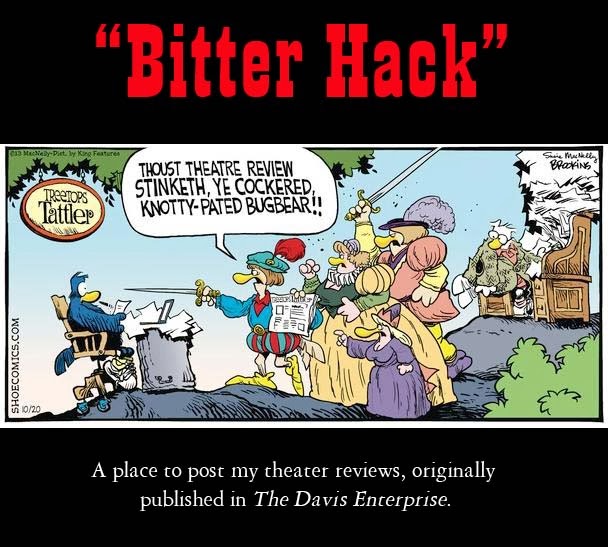It was 25 years ago, in December of 1985, when a group of theater folk in Winters, with $37 to their name, decided to put on a show. This led to the founding of the Winters Community Theater, which, 25 years later, has 131 productions under its belt. More than 900 people have been involved in WCT shows, either on stage or behind the scenes, over the past 25 years. In many cases this may involve several generations of a family..
The Winters Community Theater is never going to make any splash in any big theatrical arena, but you couldn’t find more pride or more sincerity in a group anywhere. From the big smiles and hearty welcomes that patrons receive, to the cheesecake and champagne served on opening night, to the great support that the audiences give to the cast on stage. Opening night audiences seem to be comprised mostly of friends or relatives of the cast. It’s like the Davis Comic Opera Company in its early years, and it’s a real feel good night of theater.
I had never heard of the Winters Community Theater before I became a critic, but in the past five years I have seen many productions, some better than others. I had been warned that the current production, “A Christmas Story” was “a little rough still,” so I was prepared for anything.
To my delight, this production of Jean Shepherd’s delightful Christmas classic is one of the better productions I’ve seen from this company. With 19 characters, played by 12 actors, seven of whom are children, this may be one of the larger shows presented by this company. Director Howard Hupe has made some excellent casting choices.
Mark Dahn, in the role of the adult Ralph was a joy to watch as the play progresses. The adult Ralph acts as the narrator of this story about one special Christmas memory from his childhood, a child of the 1940s. Dahn was fine as the play began, but as his rapport with the audience grew, he relaxed in his part and was delightful to watch.
Brandon Emery was perfect as the 9 year old Ralphie, the boy whose one dream for Christmas was an official, Red Ryder, Carbine-action, 200-Shot, Range Model, Air Rifle. Brandon fantasizes meetings with Red Ryder himself and campaigns to convince his parents to get him the rifle for Christmas, though his mother (Gina Wingard) poo-poo’s the idea with every mother’s perennial excuse, “You’ll put your eye out.”
Wingard flawlessly portrays a wife and mother of the 40s, constantly putting on her apron, cooking dinner for her family, showing she’s really smarter than her husband, while at the same time making her husband feel the head of the household, though it is really she who runs the place.
Trent Beeby is Ralphie’s father. This “Old Man” is straight out of a 50s sitcom, in the best tradition of an Ozzie Nelson, a man who is head of the household, but who still can’t quite get it right most of the time, whether it’s the house furnace, or car problems, or the dogs next door who are out to get him.
Ralphie’s younger brother, Randy (Loren Tolley) is cute as a button, with terrific facial expressions. and a comfortable stage presence. When Mother wraps him up in many layers to go out and play in the snow, he looks like a character out of SouthPark.
Ralphie’s best friends, Flick (Tommy Halbach) and Schwartz (Andrew Gonzales) may have been a bit stilted in their line delivery, but it more came across as the way that a group of 9 year olds might have interacted with each other. Halbach is particularly funny in the tongue-on-the-light pole scene.
Lauren Hupe is Esther Jane, with a huge crush on Ralphie. Lauren and her sister (I assume), Elaina, are third generation Winters Theater actors, doing a good job of carrying on the family tradition.
Helen (Olivia Orosco) is another classmate, having the opportunity to perform on stage with her father, Rodney Orosco, a Big Elf in the Santa scene.
Cori Beeby’s height makes her an imposing bully to the shorter boys, though with her hair tucked under her hat, she easily passes for a boy.
Jim Hewlett plays several roles: Santa Claus, The Cowboy, the Tree Lot Owner, the Delivery Man and the Neighbor. He is best as the cowboy in the conversations with Ralphie.
Additional children in the cast are Elaina Hupe, William Halbach (another third-generation actor) and Trichelle Leslie. Ralphie’s teacher is Joann May.
Howard Hupe has directed this delightful Christmas pastiche. It’s a bright, witty script and the cast delivers it well. It’s worth the trip out to Winters to get your holiday season started with an classic story told lovingly by this dedicated group of thespians.






